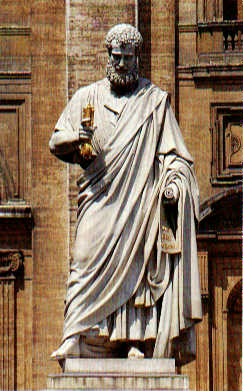
THST 398.04
Peter & Paul:
Early Christians in Rome
LMU Rome Program
Summer 1999
Felix Just, S.J
Loyola Marymount University

 |
THST 398.04Peter & Paul:Early Christians in RomeLMU Rome ProgramSummer 1999Felix Just, S.J Loyola Marymount University |
 |
Click here for general information on the 1999 Summer Program in Rome from LMU's Study Abroad Office (webpage no longer active)
Click here for more information and pictures from the Rome Center of Loyola University Chicago (our partner and host institution)
Course Description, Goals and Objectives:
Rome has not only been a major center of Western Christianity for many
centuries, but the two greatest early Christian missionaries, Peter and
Paul, both came to Rome to preach, teach, and build up the early Church,
and both were martyred there around 64 AD. In this course we will
study the beginnings and the growth of the Church in Rome, from the time
of the apostles in the first century to the official acceptance of Christianity
in the fourth century. The course has the following specific goals and
objectives:
1) To learn about the gradual growth of Christianity in its first few centuries in the Roman Empire:
- we will review some highlights of Judeo-Christian history (esp. 2nd cent. BCE to 4th cent. CE).
- we will study the social, cultural, economic, and political contexts of early Christianity.2) To become familiar with some early Christian literature, both from and after the New Testament:
- we will read a variety of New Testament texts, especially those connected with the city of Rome.
- we will read a selection of related early Christian writings not found within the New Testament.3) To experience the modern city of Rome as a living laboratory for the study of ancient Christianity:
- we will visit some museums, churches, catacombs, and other relevant sites in and around Rome.
- we will consider the difficulties that must be faced in trying to overcome a 2000-year time gap.4) To improve our academic skills, including critical reading, research, writing, and presentation skills:
- we will attempt not only to find answers, but to question presuppositions and raise new questions.
- we will share our insights with others in written assignments, oral discussions, and presentations.5) To understand and to practice doing theology as an essentially inter-disciplinary enterprise:
- we will incorporate some insights from the fields of history, literature, language, philosophy, art,
archaeology, natural and social sciences, etc., as well as using the methods of theology itself.
- we will reflect on how Christianity today is similar to and/or different from ancient Christianity.
Prerequisites:
None
Required Texts:
1) Any modern translation of the Bible; a small but good study edition is the New American Bible (New York: Catholic Book Publishing, 1988). - ISBN 089-942-9505Course Work/Expectations:2) Brown, Raymond E. & John P. Meier. Antioch and Rome: New Testament Cradles of Catholic Christianity. New York: Paulist Press, 1983. - ISBN 0-8091-2532-3 (may be out of print)
3) Chadwick, Henry. The Early Church. Penguin History of the Church, 1. Revised edition. London & New York: Penguin, 1993. - ISBN 0-14-023199-4
4) Staniforth, Maxwell, trans. Early Christian Writings: The Apostolic Fathers. Penguin Classics, 197. Revised edition by Andrew Louth. London & New York: Penguin, 1987. - ISBN 0-14-044475-0
1) Regular Attendance and Participation in Classes and Field Trips2) Daily Reading Assignments
3) Several Short (1-2 pages) Written Exercises
4) Periodic Quizzes and a Final Exam
Possible Site Visits in and around Rome:
Roman Forum and environs, including the Arch of TitusRoman Colisseum and environs, including the Arch of Constantine
Vatican City:
St. Peter's Basilica
Scavi underneath St. Peter's
Vatican MuseumsMajor Roman Basilicas:
St. Paul outside the Walls
St. John Lateran
St. Maria Maggiore
San ClementeTiber River and Environs:
Tiber Island
Jewish Synagogue & GhettoCatacombs (several)
Course Syllabus and Schedule:
More details will be posted as soon as they are available
Return to the HOME PAGE of Felix Just, S.J.
This page was last updated on 11/14/01.